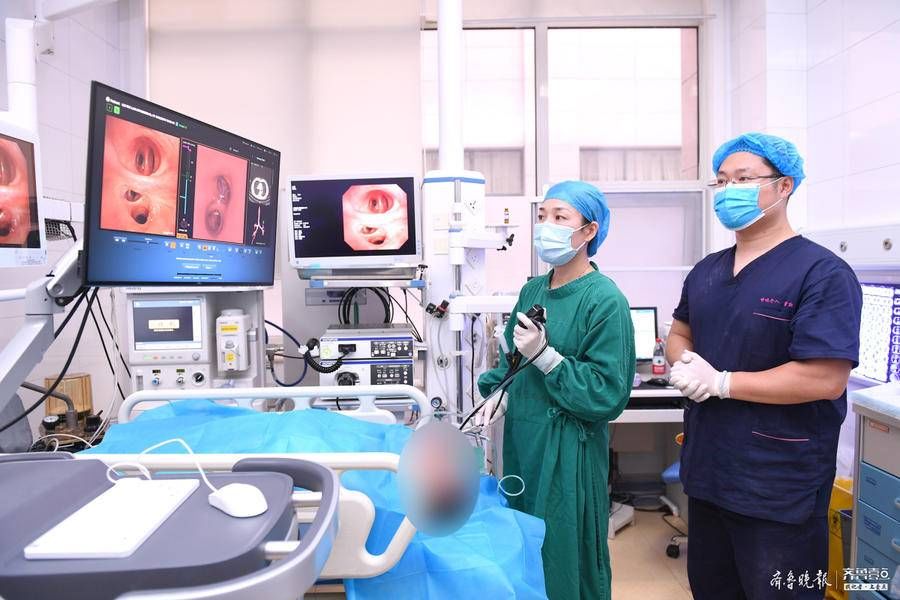Reporter Yu Wei Correspondent Zhou Jing
The patient has been suffering from wheezing for six or seven years, and is especially troubled by throat sounds every night. Recently, the respiratory interventional diagnosis and treatment center of Jining First People’s Hospital successfully placed a “safety T-tube” for it, restarting the door of breathing, and retaining the function of patients’ speaking.
The patient, a young woman in her 40s, came to Jining First People’s Hospital for treatment because of severe wheezing for several days. It turned out that the patient had undergone thyroid surgery six or seven years ago, and after the operation, he developed hoarseness, panting accompanied by throat sounds. Recently, the wheezing worsened, and the dyspnea was admitted to the hospital.
Bian Cuixia, director of the respiratory interventional diagnosis and treatment center of Jining First People’s Hospital, said that after admission to the hospital, the neck and chest CT, laryngoscopy, and bronchoscopy were promptly completed for the patient, and it was found that the patient had no obvious airway. Stenosis, when the patient inhales, the neck depression is very obvious. Laryngoscopy found that the patient’s vocal cord abduction is limited, which is a symptom of vocal cord paralysis. In order to provide patients with more precise treatment, the Interventional Respiratory Treatment Center invited breast and nail surgery, otolaryngology, and critical care medicine to organize a multidisciplinary consultation. The conclusion of the consultation still considered the cause of vocal cord paralysis. After obtaining the consent of the patient and his family, it was immediately implemented for the patient. Safe T-tube placement under bronchoscopy.
For patients with this symptom, tracheotomy and tracheal tube placement have been used in the past, so that the patient cannot speak, and the safety T-tube can not only ensure the patient’s ventilation, but also does not stimulate the airway. More importantly, the patient’s speaking function can be preserved. With the careful cooperation of Bian Cuixia and her team, the operation went smoothly. A safe T tube was successfully placed in the patient. On the day after the operation, the patient got unobstructed breathing and a quiet sleep, and has been discharged from the hospital successfully.
It is reported that the safe T-tube placement technique belongs to the fourth-level bronchoscopy surgery and is one of the highest-level techniques in respiratory medicine. In this field, Jining First People’s Hospital has also been at the leading level in the province.

Related Links:
Diagnosis and Treatment Project of Jining First People’s Hospital Respiratory Intervention Center:< /p>
Biopsy, brushing, lavage for airway and lung diseases;
Mediastinal lymph node puncture and diagnosis of other mediastinal diseases;
pulmonary infection Etiological examination and bronchoscopy adjuvant therapy;
Interventional therapy for benign and malignant airway stenosis, stent placement (including thyroid tumor, esophageal tumor, malignant airway stenosis caused by primary lung tumor, tracheotomy Benign airway stenosis caused by endotracheal intubation, tuberculosis, trauma, etc.);
Endoluminal treatment of airway tumors;
Blocking of benign and malignant airway fistulas ( (including tracheoesophageal fistula, airway-thoracic-gastric fistula, postoperative bronchial stump fistula, biliary pleural fistula, bronchopleural fistula, etc.); early diagnosis and treatment of pulmonary nodules; emphysema, bullae , bronchoscopy and thoracoscopic interventional therapy for refractory pneumothorax;
bronchoscopy interventional therapy for refractory asthma;
percutaneous lung puncture diagnosis of lung tumors and ablation therapy;
thoracoscopic diagnosis and treatment of pleural disease;
large volume lung lavage for pneumoconiosis and alveolar proteinosis, etc.